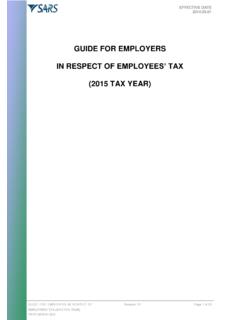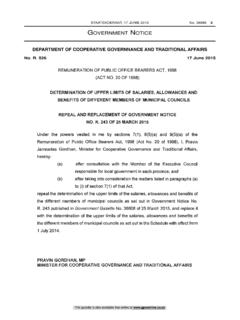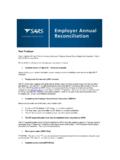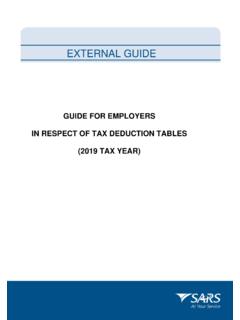Transcription of PAYE-GEN-01-G02 - Guide for Employers iro Fringe …
1 EXTERNAL REFERENCE GUIDEGUIDE FOR EMPLOYERSIN RESPECT OF Fringe BENEFITS(2015 TAX YEAR) Guide FOR Employers IN RESPECT OF Fringe BENEFITS (2015 TAX YEAR) PAYE-GEN-01-G02 Revision: 6 EFFECTIVE DATE: information contained in this Guide is intended as guidance only and is not considered to be a legal reference, nor is it a binding ruling. The information does not take the place of legislation and readers who are in doubt regarding any aspect of the information displayed in the Guide should refer to the relevant legislation, or seek a formal opinion from a suitably qualified more information about the contents of this publication you may: Visit the SARS website at Visit your nearest SARS branch Contact your own tax advisor/tax practitioner If calling from within South Africa, contact the SARS Contact Centre on 0800 00 SARS (7277) If calling from outside South Africa, contact the SARS Contact Centre on +27 11 602 2093 (only between 8am and 4pm South African time).
2 EFFECTIVE DATE Guide FOR Employers IN RESPECT OF Fringe BENEFITS (2015 TAX YEAR) PAYE-GEN-01-G02 Revision: 6 Page 2 of 30 TABLE OF CONTENTS 1 PURPOSE 3 2 SCOPE 3 3 REFERENCES 3 LEGISLATION 3 CROSS REFERENCES 3 4 DEFINITIONS AND ACRONYMS 4 5 GENERAL AND OBLIGATIONS OF THE EMPLOYER 11 6 BENEFITS GRANTED TO RELATIVES OF EMPLOYEES AND OTHERS 12 7 TAXABLE BENEFITS 13 ACQUISITION OF AN ASSET AT LESS THAN THE ACTUAL VALUE 13 RIGHT OF USE OF AN ASSET 14 RIGHT OF USE OF A MOTOR VEHICLE 15 MEALS, REFRESHMENTS AND MEAL AND REFRESHMENT VOUCHERS 18 ACCOMMODATION 19 FREE OR CHEAP SERVICES 22 LOW INTEREST OR INTEREST FREE LOANS 23 SUBSIDIES IN RESPECT OF LOANS 25 EMPLOYER CONTRIBUTIONS TO INSURANCE POLICIES SCHEMES 25 PAYMENT OF EMPLOYEE S DEBT OR RELEASE OF EMPLOYEE FROM AN OBLIGATION TO PAY A DEBT 26 MEDICAL SCHEME CONTRIBUTIONS PAID BY AN EMPLOYER 27 MEDICAL COSTS INCURRED BY AN EMPLOYER 28 8 QUALITY RECORDS 29 9 DOCUMENT MANAGEMENT 29 EFFECTIVE DATE Guide FOR Employers IN RESPECT OF Fringe BENEFITS (2015 TAX YEAR) PAYE-GEN-01-G02 Revision: 6 Page 3 of 30 1 PURPOSE The purpose of this document is to assist Employers in understanding their obligations relating to determining the cash equivalent of the value of a taxable Fringe benefit as provided for in the Seventh Schedule to the Income Tax Act.
3 2 SCOPE This basic Guide explains the methods to be applied by Employers in determining the taxable Fringe benefit and includes the legislative requirements as well as examples. 3 REFERENCES LEGISLATION TYPE OF REFERENCE REFERENCE Legislation and Rules administered by SARS: Seventh Schedule to the Income Tax Act No. 58 of 1962: Paragraph 2(a) to 2(k) and 3,4,5,6,7,8,9,10,10(a),11,12,12A,12B,12C , 13,16,17,18,19 of the 7th Schedule Section 10(1) 6A Tax Administration Act No. 28 of 2011: Section 1 The Employment Tax Incentive Act No. 26 of 2013 Other Legislation: None CROSS REFERENCES DOCUMENT # DOCUMENT TITLE APPLICABILITY PAYE-AE-06-G01 Guide for completion and submission of employees tax certificates All PAYE-AE-06-G02 Guide for completion and submission of reconciliation declarations All PAYE-AE-06-G03 Guide for validation rules for fields applicable to reconciliation documents All PAYE-AE-06-G04 Guide for codes applicable to Employees Tax certificates All PAYE-AE-06-G05 Guide for the creation of CSV files employees tax certificate information All PAYE-AE-06-G06 Guide for PAYE e@syFile Employer for Employee IT Registration or Verification All PAYE-AE-06-POL01 Completion and submission of reconciliation documents All PAYE-GEN-01-G01 Guide for employer in respect of Employees Tax Deduction Tables All PAYE-GEN-01-G01-A01 Weekly tax deduction tables All PAYE-GEN-01-G01-A02 Fortnightly tax deduction tables All PAYE-GEN-01-G01-A03 Monthly tax deduction tables All
4 PAYE-GEN-01-G01-A04 Annual tax deduction tables All PAYE-GEN-01-G03 Guide for Employers in respect of allowances All PAYE-GEN-01-G03-A01 Rate per kilometre schedule All PAYE-GEN-01-G03-A02 Subsistence allowance in respect of Foreign Travel All PAYE-GEN-01-G04 Guide for employer in respect of Employees Tax All PAYE-GEN-01-G05 Guide for Employers in respect of Employment Tax Incentive All SDL-GEN-01-G01 Guide for Employers in respect of the SDL All UIF-GEN-01-G01 Guide for Employers in respect of UIF All EFFECTIVE DATE Guide FOR Employers IN RESPECT OF Fringe BENEFITS (2015 TAX YEAR) PAYE-GEN-01-G02 Revision: 6 Page 4 of 30 4 DEFINITIONS AND ACRONYMS 4th Schedule The Fourth Schedule to the Income Tax Act No 58 of 1962. 7th Schedule The Seventh Schedule to the Income Tax Act No 58 of 1962. Alternate period A period, whether of 12 months or not, commencing on the day following the last day of the preceding alternate period in relation to the employer and ending on a date falling not more than 14 days before or after the last day of February, or such greater number of days as the Commissioner, having regard to the circumstances of the case, may allow.
5 Annual equivalent An amount equal to the sum of net remuneration multiplied by the ratio which a full year bears to the period in respect of which such net remuneration is payable. Annual payment An amount of net remuneration that is, in accordance with the employee s conditions of service or the employer s practice, paid in a lump sum to the employee or it is an amount that is calculated without reference to a period. Associated person (in relation to an employer) for ETI purposes only Where the employer is a company, it means that any other company which is associated with that employer by reason of the fact that both companies are managed or controlled directly or indirectly by substantially the same persons; or Where the employer is not a company, it means that any company which is managed or controlled directly or indirectly by the employer or by any partnership of which the employer is a member; Backdated salary Salary, wage or similar remuneration (excluding a bonus) payable by the employer to an employee.
6 Balance of remuneration Any amount of remuneration after deducting the allowable deductions for Employees Tax purposes. Broad-based employee share plan A plan in terms of which: equity shares in that employer, or in a company that is an associated institution in relation to the employer, are acquired by employees from that employer, for consideration which does not exceed the minimum consideration required by the Companies Act, 1973; employees who participate in any other equity scheme of the employer or of a company that is an associated institution in relation to the employer, are not entitled to participate and where at least 80% of all other employees who are employed by the employer on a permanent basis on the date of grant are entitled to participate; the employees who acquire the equity shares are entitled to all dividends and full voting rights in relation to those equity shares.
7 And no restriction have been imposed in respect of the disposal of the equity shares, other than: o a restriction imposed by legislation; o a right of any person to acquire those equity shares from the employee or former employee who acquired the equity share: in the case where the employee or former employee is or was guilty of misconduct or poor performance, at the lower of market value on the date of the grant or acquisition by that employer; or in any other case, at market value on the date of acquisition by that person.; or o a restriction in terms of which the person who acquired the equity shares may not dispose of the equity shares for a period which may not extend beyond five years from the date of grant. EFFECTIVE DATE Guide FOR Employers IN RESPECT OF Fringe BENEFITS (2015 TAX YEAR) PAYE-GEN-01-G02 Revision: 6 Page 5 of 30 CCMA The Commission for Conciliation, Mediation and Arbitration.
8 Commissioner The Commissioner for the South African Revenue Service. Employee An employee for Employees Tax purposes is defines as: A natural person who receives remuneration or to whom remuneration accrues; A person (including a company) who receives remuneration or to whom remuneration accrues by reason of services rendered by such person to or on behalf of a labour broker; A labour broker; A person or class or category of persons whom the Minister of Finance by notice in the Government Gazette declares to be an employee; A personal service provider; A director of a private company. An employee for UIF purposes is defined as any natural person who receives any remuneration or to whom remuneration accrues in respect of services rendered or to be rendered by that person but excluding an independent contractor An employee for SDL purposes is defined as an employee for Employees Tax purposes An employee for taxable benefit purposes is defined as any person who receives remuneration or to whom remuneration accrues and includes any director of a company but excludes persons who retired before 1 March 1992 except for purposes of the provisions which deal with the payment of an employee s debt or the release of an employee from an obligation to pay a debt.
9 Employees Tax An amount of tax that an employer must deduct from all regular or periodic payments (remuneration), paid or which becomes payable to an employee Employer Any person who pays or is liable to pay a person an amount by way of remuneration including a person responsible for the payment of an amount by way of remuneration to a person under the provisions of a law or out of public funds or out of funds voted by parliament or Provincial Council. This definition excludes any person not acting as a principal but includes any person acting in a fiduciary capacity or in his/her capacity as a trustee in an insolvent estate, an executor or an administrator of a benefit fund, pension fund, pension preservation fund, provident fund, provident preservation fund, retirement annuity fund or any other fund. Equity instrument Means a share or a member s interest in a company, including: an option to acquire such a share, part of a share or member s interest; any financial instrument that is convertible to a share or member s interest; and any contractual right or obligation the value of which is determined directly or indirectly with reference to a share or member s interest.
10 ETI Act Employment Tax Incentive Act No. 26 of 2013 Gain A gain for purposes of a broad based employee share plan and qualifying equity instruments means the amount by which any amount received by or accrued to the employee from the disposal exceeds the consideration given by the employee for the qualifying equity share, right or interest. Holder of a public office The President, Deputy President, a Minister, a Deputy Minister, a member of the National Assembly, a permanent delegate to the EFFECTIVE DATE Guide FOR Employers IN RESPECT OF Fringe BENEFITS (2015 TAX YEAR) PAYE-GEN-01-G02 Revision: 6 Page 6 of 30 National Council of Provinces, a Premier, a member of an Executive Councillor, a member of a provincial legislature; Any member of a municipal council, a traditional leader, a member of a provincial House of Traditional Leaders or a member of the Council of Traditional Leaders.









